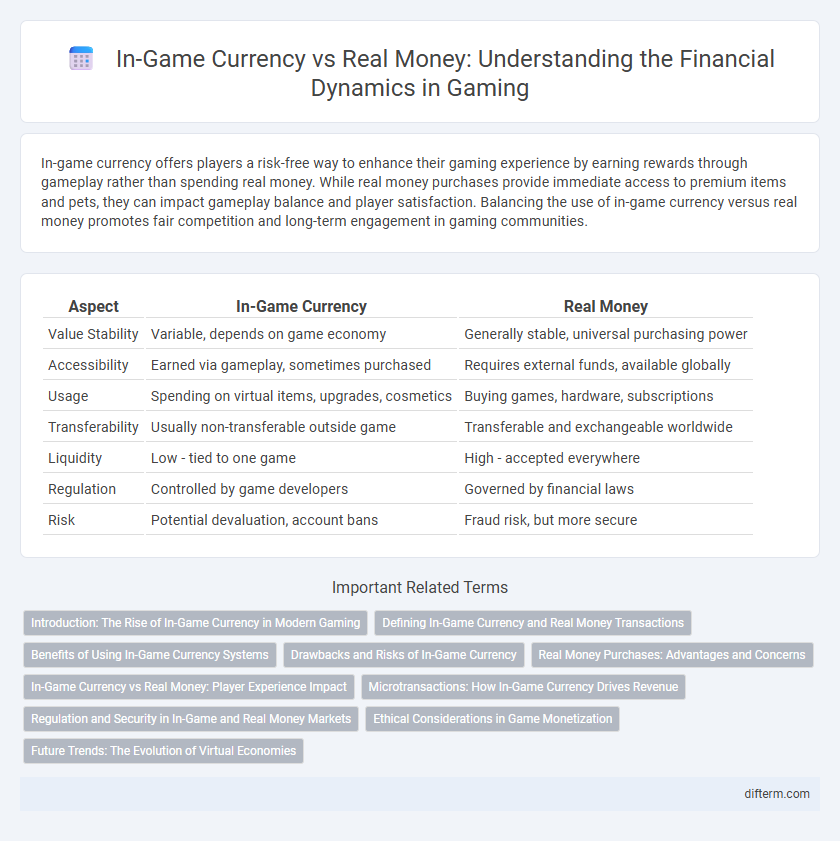In-game currency offers players a risk-free way to enhance their gaming experience by earning rewards through gameplay rather than spending real money. While real money purchases provide immediate access to premium items and pets, they can impact gameplay balance and player satisfaction. Balancing the use of in-game currency versus real money promotes fair competition and long-term engagement in gaming communities.
Table of Comparison
| Aspect | In-Game Currency | Real Money |
|---|---|---|
| Value Stability | Variable, depends on game economy | Generally stable, universal purchasing power |
| Accessibility | Earned via gameplay, sometimes purchased | Requires external funds, available globally |
| Usage | Spending on virtual items, upgrades, cosmetics | Buying games, hardware, subscriptions |
| Transferability | Usually non-transferable outside game | Transferable and exchangeable worldwide |
| Liquidity | Low - tied to one game | High - accepted everywhere |
| Regulation | Controlled by game developers | Governed by financial laws |
| Risk | Potential devaluation, account bans | Fraud risk, but more secure |
Introduction: The Rise of In-Game Currency in Modern Gaming
In-game currency has revolutionized the gaming economy by enabling players to purchase virtual items, upgrades, and exclusive content without spending real money directly. Games like Fortnite and Roblox have integrated digital currencies such as V-Bucks and Robux, fostering player engagement and driving extensive microtransaction revenue. The rise of in-game currency reflects a shift towards immersive, player-driven economies that blend entertainment with real-world financial implications.
Defining In-Game Currency and Real Money Transactions
In-game currency refers to virtual money earned or purchased within a game, used to buy items, upgrades, or services exclusive to that game environment. Real money transactions involve players spending actual fiat currency to acquire in-game currency or directly purchase digital goods, often through microtransactions. Understanding the distinction between these two forms of currency is crucial for navigating game economies and managing spending habits effectively.
Benefits of Using In-Game Currency Systems
In-game currency systems enhance player engagement by allowing seamless transactions within the virtual environment, fostering a sense of accomplishment without real-world financial risk. These currencies provide a controlled economic ecosystem, enabling developers to balance gameplay and introduce exclusive content, boosting retention rates. Players benefit from increased accessibility and flexibility, as in-game currencies often reward skill and time investment rather than just monetary spending.
Drawbacks and Risks of In-Game Currency
In-game currency often lacks real-world value, creating a disconnect between spending habits and actual financial impact, which can lead to overspending without users realizing the extent. The risk of currency devaluation or sudden game updates can render accumulated in-game funds worthless, causing frustration and financial loss for players. Furthermore, the prevalence of scams and fraudulent marketplaces targeting in-game currency transactions increases the risk of account compromise and monetary theft.
Real Money Purchases: Advantages and Concerns
Real money purchases in gaming offer players immediate access to exclusive items, enhanced customization, and time-saving options, boosting overall gameplay experience. However, these transactions raise concerns regarding pay-to-win dynamics, potential addiction, and financial transparency. Developers must balance monetization strategies to ensure fair play while sustaining revenue streams.
In-Game Currency vs Real Money: Player Experience Impact
In-game currency enhances player engagement by providing a sense of progression and achievement within the game environment, often driving microtransactions and boosting player retention. Real money transactions, while offering immediate access to premium items or power-ups, can sometimes disrupt game balance and affect fairness, impacting overall player satisfaction. The dynamic between these two economies significantly influences the gaming experience, shaping player motivation and perceived value.
Microtransactions: How In-Game Currency Drives Revenue
Microtransactions leverage in-game currency to create a seamless purchasing experience that boosts player engagement and spending. By offering virtual coins, gems, or tokens, developers encourage frequent small transactions instead of one-time purchases, significantly increasing overall revenue. This strategy capitalizes on psychological incentives, making players more likely to invest real money in digital assets and enhancements.
Regulation and Security in In-Game and Real Money Markets
In-game currency markets face unique regulatory challenges compared to real money transactions, as virtual economies often lack standardized oversight, increasing risks of fraud and money laundering. Regulatory bodies are increasingly implementing frameworks to ensure transaction transparency, consumer protection, and anti-money laundering compliance within both digital and real money markets. Security measures such as blockchain verification and multi-factor authentication are becoming critical to safeguard users' assets and prevent unauthorized access in gaming ecosystems.
Ethical Considerations in Game Monetization
In-game currency allows players to engage with virtual economies without direct real-money transactions, reducing financial risks and encouraging fair play within game ecosystems. Ethical considerations in game monetization demand transparency about the conversion rates between in-game currency and real money to prevent exploitation and promote responsible spending. Developers must avoid predatory practices like pay-to-win models or excessive microtransactions that can disproportionately affect vulnerable players, fostering a balanced and equitable gaming environment.
Future Trends: The Evolution of Virtual Economies
In-game currency systems are increasingly integrating blockchain technology to enable secure, transparent transactions and true ownership of virtual assets. Future trends indicate a shift toward hybrid economies where digital currencies can be exchanged seamlessly with real money across multiple gaming platforms and metaverses. Enhanced AI-driven dynamic pricing models will further personalize economic experiences, driving player engagement and evolving the virtual economy landscape.
in-game currency vs real money Infographic

 difterm.com
difterm.com